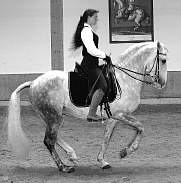
It occurred to me last night that it must be a very arduous task to write a book on the art of equitation. I struggled to find the right point at which to start my ramblings, only to come unstuck at almost the first hurdle. Of course I should have covered *the seat* first, shouldn't I?? So if you have Anja Beran's book, please read her concise descriptions of seat, legs and hands. One of the most important things for me is to train your legs to *let go*. In all my descriptions of turning it is assumed therefore that both before and after the aid the leg is hanging in a relaxed manner, not tense or squeezing in any way. The same also for in-hand/ground work, use the aid and then stop using it and only re-apply the aid when necessary.
Jane mentioned about teaching a baby on the ground and then taking this work forward to the early ridden work. One of the things I want to use with Chapiro when the time comes is to ride the early work with reins to the cavesson and later introduce the idea of the bit. At the same time I hope to be able to be educating him in the art of flexion and relaxation of the jaw whilst in-hand. This should, in theory, mean that I can keep the bit to converse with him rather than to turn him.
When we bring an unhandled youngster onto the yard for the first time it is going to be a very new experience for them. Yet, most horses, once haltered for the first time will lead away with some success, it's pretty much the case that if you have their head the rest is compelled to follow. This was the case with Chapiro, he had been handled but very little and had no manners to speak of. He had been weaned and then ultimately returned to the same paddock as his mother and at least one other mare. Now this was unfortunate but sometimes it just isn't possible to do the right thing at the right time. When I bought him at just turned two he had already covered a mare and rather assumed he was head honcho about the place. All my work with him has therefore involved teaching him to get outta my space whilst learning to lead calmly and quietly. To do this I have worked him loose in the barn and school, rope circled with him and a little baby lunging; most effective of all, however, has been our lessons in leading out. I am pretty chuffed that most of the time he will now follow behind me on the lead, slightly to my side (nose towards my leading hip) and stops when I stop, backs when I back. Of course there are times when he gets cocky and advances too quickly but I either swing the coiled lunge line in the space he wants to move into or turn him on a circle and line him back up with my hip and off we go again.
So what does all that have to do with turning?? Well yes we can turn a horse by putting their heads into a position and thus compelling their bodies to follow but what I've found is that it's really the placing of our own bodies and the use of body language that compells a horse to move or change direction.
In the beginning then we can use the obvious benefits of controlling the head but ultimately it is a crude control and as we progress our youngster we will rely on it less and less but where will this leave us when we want to climb on board.......to be continued
8 comments:
oo er...
are you planning a book yourself, then!
Good lord no!! There are so many great books out there written by such knowledgeable folks. However, I do think there is a gap out there but it won't be me filling it.
Well I'm really looking forward to the book......! :-)
oh go on ....
well turns are about
1. where your own weight is, seat bones and that...
2. where the pressure on the horse is ... outside rein, inside hand...
it's a combination of all of that and putting it together in the right order is the difficulty...
Never mind the book! Look forward to reading your thesis on turning when my brains less tired!! (Thought pic of you looked particularly impressive .... and then realised it was Anja Beran!!)
If I was clever I could have photoshopped my face onto the 'pic Jane!!
Ooh, I'm so glad to be back!!! I've missed this!
Post a Comment